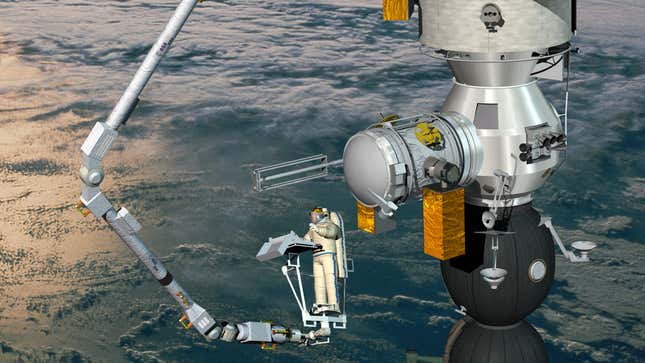
The European Space Agency is finally ready to deliver its new robotic arm to the International Space Station. The 37-foot-long arm features an array of impressive features, including the ability to work autonomously and “walk” across the exterior of the orbital outpost.
Originally designed to fly on NASA’s Space Shuttle, the European Robotic Arm (ERA) is finally going to space after “two decades of technical and programmatic challenges,” according to the European Space Agency. The arm, along with a new Russian module named Nauka, are scheduled to launch atop a Proton rocket from the Baikonur Cosmodrome on July 15, 2021.
A European consortium led by Airbus Defense and Space in the Netherlands developed the robotic arm for ESA. Airbus designed the arm and its software functions and also tested the system.

The arm, equipped with seven joints (one at the elbow and three on each wrist), measures 37 feet (11.3 meters) in length and has a reach of 31.8 feet (9.7 meters). The two-handed device features a symmetrical design, so there’s no true top or bottom to the arm. Because of this, ERA can “walk” across the ISS exterior, moving hand-over-hand as it travels from one fixed anchor point to another. So it’s basically a large, robotic inchworm capable of working in space.
ERA is launching with Nauka, also known as the Multipurpose Laboratory Module, and two control stations (one internal and one external). The arm will begin its duties on the new module, becoming the first robotic device to service a Russian segment.

On its arrival to the space station, ERM will join Canadarm2 and the Japanese Experiment Module Remote Manipulator System (JEMRMS), neither of which can reach the Russian segment. Incompatible base points and payload mounting units don’t allow Canadarm2 and JEMRMS to function on other parts of the station, according to ESA. ERA’s first tasks will be to set up the airlock and install a radiator inside the new Nauka module.
The versatile arm can be controlled remotely by ISS astronauts or cosmonauts, whether they’re inside or outside the station. ERA has its own internal computer and can perform tasks either fully or semi-autonomously. The tip of each arm is like a Swiss Army Knife, equipped with an electrical power outlet, data bus, video line, and a rotating drive machine.
The arm can work to a precision of 5 millimeters and move loads as heavy as 17,640 pounds (8,000 kg). The ISS crew will use the arm to move payloads, install solar arrays, transport spacewalking astronauts from spot to spot, inspect the station with infrared cameras, and generally assist with jobs outside the station.

The ISS is expected to remain in service until around 2030, but the future of the outpost is in doubt. In early June, Russia’s space chief threatened to leave the station in four years unless the U.S. lifts sanctions that are hurting the country’s space sector. It would be a shame to see the Russians leave, especially given the pending arrival of the new arm and module.